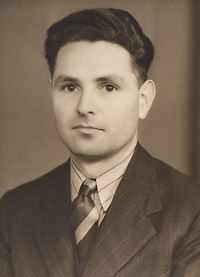


Developing dental education and research in Victoria
Introduction
Participants
Building a dental research culture
The influence of Frank Wilkinson
Developing linkages between the Dental School and Dental Hospital
The art and science of dentistry
The introduction and impact of fluoridation
Resolving a long-standing dispute with dental technicians
Training of dental health therapists
Dentistry's relationship with hospitals, government and industry
Controversy over the Dental School quota
The relationship between the School and the University of Melbourne
Relations between the School and the Australian Dental Association
The role of the School in childhood dental health
Funding research through the CRC and other programs
Personalities
Appendix; Some further thoughts stimulated by the Witness seminar
Endnotes
Index
Search
Help
Contact us

Henry Atkinson: It had been going on for a long time in the United Kingdom. Then, it started here with Frank Wilkinson who worked with Professor Neil Greenwood[38] from the Department of Metallurgy. They set up a postgraduate course in what they hoped would be dental materials. Greenwood then employed Howard Worner,[39] a recent metallurgy graduate, to run this laboratory[40] with Eddie Marks[41] who was a dentist. They worked on the properties of amalgam.

From that came the Dental Materials Research Laboratory established in 1928 by Greenwood and Wilkinson. It was renamed the Commonwealth Bureau of Dental Standards during World War II and, in 1947, the Laboratory was transferred completely to the Commonwealth Health Department and at the same time moved to the University campus, near the main gate in a temporary wooden hut.[42]
Ann Westmore: What impact did that have on the Dental School?
Henry Atkinson: It was one of the greatest tragedies that happened to the School because we in the Dental School sold the Laboratory, or gave it away, to the Commonwealth. So the research on materials science within the School disappeared.
John Harcourt: A number of us did utilise the facilities as students for our Masters degree, First Part.
Ann Westmore: How was research recaptured by the School?
Hector Orams: The Masters degree I think was originally done by examination, Part One and Part Two. Part One was in the basic sciences and the only structured course was the one in materials science. Anybody who took up other subjects, like physiology or pathology, had to go across to the medical school and sit in on the medical students’ lectures. There wasn’t a structured course for them. Part Two was done in a specialty area of choice, such as oral surgery or conservative dentistry.
Later this was altered and students could elect to do Part Two by thesis, which stimulated research.
I think in the early days there was no real structured guidance for the research apart from the metallography (materials science) section. There was no PhD program at that stage.
Peter Reade: I think Tony Storey had PhD students.
John Harcourt: A number of people before that had Doctor of Dental Science degrees (which were established before the Masters degrees) which involved unsupervised research, though they had an adviser. There was no real supervision or time limit.
Hector Orams: Except old age. (laughter)
Henry Atkinson: The Masters Degree had been on the books since the beginning, I think.[43] It was controlled by the Department of Dental Medicine and Surgery. They had the final say in Part Two. I tried to get it changed to a research degree because the University was doing that. All their Masters were going to course work and mini-thesis. We got it to the stage where it was passed through Faculty, then there was a sudden change of mind at Faculty and it was thrown out. It took two more years work before research came in.
When I started I tried to get the PhD introduced into dentistry but it was not possible because the DDSc, which had produced its first graduates in about 1913, was our other program. Eventually the PhD was permitted when Tony came. I think there were one or two people in the dental department who transferred from a DDSc to a PhD. Had we not done that, we wouldn’t have got funds for research.
 |
Witness to the History of Australian Medicine |  |
© The University of Melbourne 2005-16
Published by eScholarship Research Centre, using the Web Academic Resource Publisher
http://witness.esrc.unimelb.edu.au/097.html